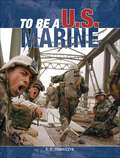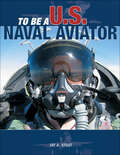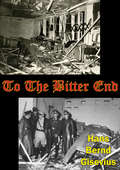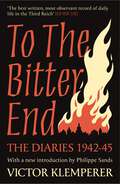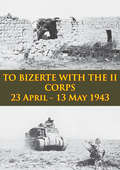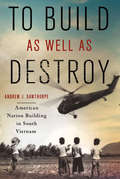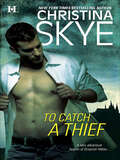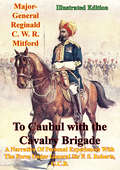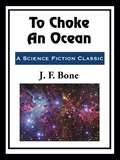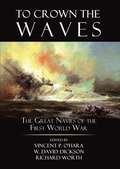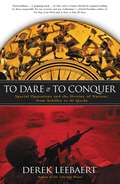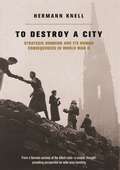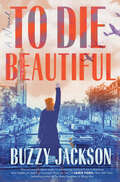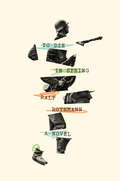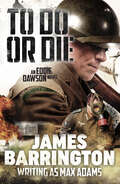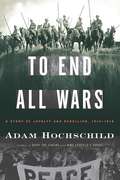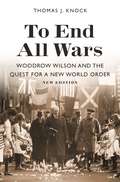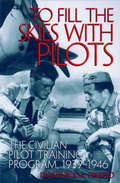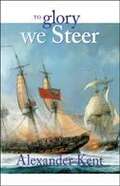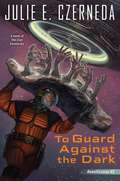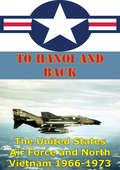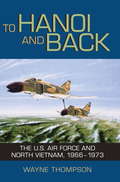- Table View
- List View
To Be a U.S. Marine (To Be A)
by S. TomajczykComprised of smart, highly adaptable men and women, the Marine Corps serves as the aggressive tip of the U.S. military spear. Theirs is a smaller, more dynamic force than any other in the American arsenal, and the only forward-deployed force designed for expeditionary operations by air, land, or sea. It is their size and expertise that allow them to move faster. Working to overcome disadvantage and turn conflict into victory, they accomplish great things, and they do so together. In the Marine Corps, there is a motto that describes their commitment to each other, their organization, and their country. It is Semper Fidelis or "Semper Fi." Translated from Latin, it means "Always Faithful."- Superb full-color action photos- Behind the scenes look at the training and structure- Next book in the colorful and successful series covering America's military forces- Still one of America's most combat efficient forcesFeatures:Chronological photographic displays, with personal stories, of a class of recruits as they progress through Marine recruit training.Steve Tomajczyk gains unprecedented access to the men in training around the country, including California, North Carolina, Virginia, and Okinawa.Superb full-color action photos.Author Steve Tomajczyk takes you through Marine recruit training - "Boot Camp" - the 13-week process that transforms a young person with the courage to succeed into a mature, highly disciplined, and fully capable Marine. During this time drill instructors teach individuals how to care for themselves and others, function as a member of a team and to achieve success together. Training includes first aid, water survival skills, marksmanship, tactics and other related topics. Training also focuses on customs, traditions and history that have made the Marine Corps respected around the world.About the AuthorS.F. Tomajczyk has written numerous books on weapons, agencies, and other aspects of the U.S. military and warfare, including Black Hawk, Bomb Squads, and Carrier Battle Group. Tomajczyk lives in Loudon, New Hampshire.
To Be a U.S. Naval Aviator (To Be A)
by Jay A. StoutFor anyone with the will to become a U.S. naval aviator, the future begins now. Marine fighter pilot and combat veteran Jay Stout shows us just what it takes to be a U.S. naval aviator in the twenty-first century, conducting us through every step of training as these dedicated, everyday heroes prepare for tomorrow’s threats while taking the fight to the enemy today. Throughout, Stout offers behind-the-scenes perspectives on the community of naval aviators, with profiles of the men and women who fly naval aircraft, of celebrated naval aviators, and of important figures in the history of naval aviation.
To Become a Bride (Bachelor Sisters Ser. #2)
by Carole MortimerFrom the first, Danie clashed swords with Jonas Noble, realizing that he was determined not to disclose the reasons for his dealings with her family.But Danie also found Jonas incredibly attractive, which made her plan to discover his motives all the harder to follow; the closer she got to Jonas, the more she fell in love! However, her heart was quietly breaking because of the secret she was hiding...a secret that would surely prevent what she really wanted: to become Jonas's bride...
To The Bitter End: An Insider's Account Of The Plot To Kill Hitler, 1933-1944
by Hans Bernd Gisevius Richard Wilson“When on July 20, 1944, a bomb—boldly placed inside the Wolf’s Lair (Hitler’s headquarters in East Prussia) by the German Anti-Nazi Resistance—exploded without killing the Führer, the subsequent coup d’état against the Third Reich collapsed. Most of the conspirators were summarily shot or condemned in show trials and sadistically hanged. The conspiracy involved a wide circle of former politicians, diplomats, and government officials as well as senior military men. The Resistance had started as early as 1933 and involved several planned putsches and assassination attempts. Hans B. Gisevius knew or met the major figures—including Beck, Canaris, Oster, Goerdeler, and von Stauffenberg—and barely escaped after the coup’s failure. One of the few survivors of the German Anti-Nazi Resistance, Gisevius traces its history, from the 1933 Reichstag fire to Germany’s defeat in 1945, in a book as riveting as it is exceptional.”-Print ed.
To The Bitter End: The Diaries of Victor Klemperer 1942-45
by Victor KlempererThe international bestselling record of a German Jew in Nazi Germany.'Deserves to stand beside the diary of Anne Frank as a day-to-day description of the sufferings of the victims of Hitler's evil regime' EVENING STANDARD'Few English readers will fail to be moved as I was - ultimately to the point of tears' SUNDAY TELEGRAPH'Packed with vivid observation, profound reflection ... they find hope, dignity and even tart humour in the jaws of hell' INDEPENDENT ON SUNDAYA sensation when first published, this is one of the most extraordinary documents of the Nazi period. The son of a rabbi, Klemperer was by 1933 a professor of languages in Dresden. Over the next decade he lost his job, his house and many of his friends, even his cat, as Jews were not allowed to own pets. Saved for much of the war from the Holocaust by his marriage to a gentile, he was able to escape in the aftermath of the Allied bombing of Dresden and survived the remaining months of the war in hiding. Throughout, Klemperer kept a diary, for a Jew in Nazi Germany a daring act in itself. This volume covers the period from the beginnings of the Holocaust to the end of the war, telling the story of Klemperer's increasing isolation, his near miraculous survival, his awareness of the development of the growing Holocaust as friends and associates disappeared, and his narrow escapes from deportation and the Dresden firebombing in 1945.Shocking and moving by turns, it is a remarkable and important document, as powerful and astonishing in its way as Anne Frank's classic.
TO BIZERTE WITH THE II CORPS - 23 April - 13 May 1943 [Illustrated Edition]
by AnonWith 18 maps & 24 Illustrations.A DELEGATION OF GERMAN OFFICERS arrived at American Headquarters south of Ferryville at 0926 on 9 May 1943. Their mission was to surrender the remnants of a once proud unit of the Wehrmacht, the formidable Fifth Panzer Army...Marshal Giovanni Messe, commanding the Italian First Army, surrendered unconditionally to the British Eighth Army on 13 May. The long battle for North Africa was ended.Troops of the II Corps, U. S. A., who had entered the fight for Africa with the invasion on 8 Nov. 1942, played a prominent role in the decisive final battle which opened on 23 April...Within 2 weeks of the Nov. landings in Northwest Africa, British and American forces under General Dwight D. Eisenhower were driving from Algeria into western Tunisia in an effort to seize the great ports of Tunis and Bizerte. German reinforcements, rushed into Africa in the nick of time, stopped the advance just short of the Tunis plain. With operations now made difficult by the rainy winter season, the Allied Army fought bitter engagements in the mountains from Sedjenane Station to Medjez el Bab. To the south, American units in hard fighting stopped savage German drives through Kasserine Pass toward the Allied base at Tebessa and kept pressure on the long Axis communications between Field Marshal Rommel and Tunis.In late March, Rommel's forces were driven from the Mareth Line toward the north. Protecting his line of retreat, the enemy fought a stubborn delaying action against the Americans and the British in the El Guettar-Gafsa area. By 22 April the equivalent of 5 Italian and 9 German divisions were at bay for what they planned to be a protracted defense of Tunis and Bizerte. But the Axis was not allowed a breathing space to strengthen its defenses. The Allied forces, united under General Sir Harold R. Alexander as the Eighteenth Army Group, were already preparing the blow that was to destroy the enemy forces in a battle lasting 21 days.
To Build as Well as Destroy: American Nation Building in South Vietnam
by Andrew J. GawthorpeFor years, the so-called better-war school of thought has argued that the United States built a legitimate and viable non-Communist state in South Vietnam in the latter years of the Vietnam War and that it was only the military abandonment of this state that brought down the Republic of Vietnam. But Andrew J. Gawthorpe, through a detailed and incisive analysis, shows that, in fact, the United States failed in its efforts at nation building and had not established a durable state in South Vietnam.Drawing on newly opened archival collections and previously unexamined oral histories with dozens of U.S. military officers and government officials, To Build as Well as Destroy demonstrates that the United States never came close to achieving victory in the late 1960s and early 1970s. Gawthorpe tells a story of policy aspirations and practical failures that stretches from Washington, D.C., to the Vietnamese villages in which the United States implemented its nationbuilding strategy through the Office of Civil Operations and Revolutionary Development Support known as CORDS. Structural factors that could not have been overcome by the further application of military power thwarted U.S. efforts to build a viable set of non-Communist political, economic, and social institutions in South Vietnam.To Build as Well as Destroy provides the most comprehensive account yet of the largest and best-resourced nation-building program in U.S. history. Gawthorpe's analysis helps contemporary policy makers, diplomats, and military officers understand the reasons for this failure. At a moment in time when American strategists are grappling with military and political challenges in Afghanistan, Iraq, and Syria, revisiting the historical lessons of Vietnam is a worthy endeavor.
To Catch a Thief (Draycott Abbey Romance)
by Christina Skye“Fast-paced action, vivid detail, a touch of the paranormal, and hot lovemaking will please readers of adventure romance.” —BooklistNell MacInnes can spot a forgery from a mile away. After all, she learned from the best—her father is one of the art world’s most notorious thieves. His brutal beating by the very authorities who claim to keep the world safe from harm taught her one more valuable lesson—trust no one.The last thing rugged navy SEAL Dakota Smith needs on his mission is a tempting woman he doesn’t trust. But a sketch by Leonardo da Vinci has gone missing, and the art conservator’s skill in detecting forgery would be invaluable, if only her ties to the criminal world are as dead as she says they are.Soon an edgy partnership and white-hot attraction are forged between Nell and Dakota as they race to Draycott Abbey to track down a ruthless criminal with terrorist ties before time runs out—and the da Vinci is lost forever.“Christina Skye weaves an exciting, action-packed romance that once again connects another puzzle piece to the Draycott Abbey mystery. A fabulous read!” —Fresh Fiction
To Caubul with the Cavalry Brigade -: A Narrative Of Personal Experiences With The Force Under General Sir F. S. Roberts, G.C.B. [Illustrated Edition]
by Major-General Reginald C. W. R. MitfordIncludes 6 illustrationsMajor-General Reginald Mitford recounts one of the most remarkable campaigns undertaken by British Empire forces under one of its greatest generals Field Marshal Roberts.At the time of the second Anglo-Afghan war in 1879, the author was a major with the 14th Bengal Lancers, an Indian Army regiment with a reputation second to none. He and his men were assigned to the Kabul Field Force, which was sent into the inhospitable terrain of Afghanistan to avenge the murder of the British minister Pierre Cavagnari. Assailed by elements, material shortages, rebel tribesmen and the hostile environment, Mitford made the perilous journey into the heart of Afghanistan. His story is filled with details of the mountains and valleys of Afghanistan that still have barely changed; ambushes, clashes and battle are recounted in vivid detail.
To Choke An Ocean
by J. F. BoneGourmets all agree that nothing can beat oysters on the half-shell—not even the armed might of the Terran Confederation!
To Crown the Waves
by W. David Dickson Vincent P. Ohara Richard WorthThe only comparative analysis available of the great navies of World War I, this work studies the Royal Navy of the United Kingdom, the German Kaiserliche Marine, the United States Navy, the French Marine Nationale, the Italian Regia Marina, the Austro-Hungarian Kaiserliche und Königliche Kriegsmarine, and the Imperial Russian Navy to demonstrate why the war was won, not in the trenches, but upon the waves. It explains why these seven fleets fought the way they did and why the war at sea did not develop as the admiralties and politicians of 1914 expected.After discussing each navy's goals and circumstances and how their individual characteristics impacted the way they fought, the authors deliver a side-by-side analysis of the conflict's fleets, with each chapter covering a single navy. Parallel chapter structures assure consistent coverage of each fleet-history, training, organization, doctrine, materiel, and operations-and allow readers to easily compare information among the various navies. The book clearly demonstrates how the naval war was a collision of 19th century concepts with 20th century weapons that fostered unprecedented development within each navy and sparked the evolution of the submarine and aircraft carrier. The work is free from the national bias that infects so many other books on World War I navies. As they pioneer new ways of viewing the conflict, the authors provide insights and material that would otherwise require a massive library and mastery of multiple languages. Such a study has special relevance today as 20th-century navies struggle to adapt to 21st-century technologies.
To Dare and To Conquer: Special Operations and the Destiny of Nations, from Achilles to Al Qaeda
by Derek LeebaertWriting for a general audience, Leebaert (Georgetown U.) profiles the role of small military forces utilizing surprise, stealth, and other means of force leverage in achieving victories against numerically superior enemies, occasionally changing the direction of history in the process. The narrative, which places special operations in history in the context of wider military and political organization, temporally ranges from the Trojan Horse to the US Special Operations Command and primarily focuses on the Western experience. Annotation ©2006 Book News, Inc., Portland, OR (booknews.com)
To Destroy a City: Strategic Bombing and its Human Consequences in World War II
by Hermann KnellHerman Knell was nineteen and living in Würtzburg in March of 1945 when hundreds of Allied planes arrived overhead, unleashing a torrent of bombs on the city. Würtzburg's tightly packed medieval housing exploded in a firestorm, killing six thousand people in one night and destroying 92 percent of the city's structures. Despite the fact that Würtzburg had no strategic value, the city emerged from World War II second only to Dresden in material destruction inflicted from the air. The experience led Knell to years of research on the history, development, and effects of the strategy of area bombing. To Destroy a City is the result of the author's long and unrelenting investigation. His analysis of this form of warfare, which reached its zenith during World War II, covers the history and the development of wide-area bombing since 1914, examines its wartime effectiveness and the consequences. But the extra dimension that Knell's book offers is his firsthand experience of the tension, fear, tentative defiance, and, finally, utter catastrophe of being on the receiving end of overwhelming air power. For Americans, who fortunately did not experience bombing during the war, this is essential reading.
To Die Beautiful: A Novel
by Buzzy JacksonA heartrending novel based on a true story of love, loyalty, and the limits we confront when our deepest values are tested, by award-winning writer Buzzy Jackson How far would you go to protect the people and country you love? It&’s 1940 and Hannie Schaft is a shy nineteen-year-old law student living in the Nazi-occupied Netherlands with ambitious goals for her future. But dreams die in wartime, and Hannie&’s closest friends are no longer safe as fascism insidiously rises in her country. Hiding them is not enough. Hannie may be young but she can&’t stand aside as the menace of Nazi evil tightens its grip. Driven by love and moral outrage, Hannie soon becomes an armed member of the Dutch Resistance movement. Hannie discovers her own untapped ferocity—wearing lipstick and heels to lure powerful Nazis close and assassinate them at point-blank range, and bombing munitions factories. As humanity collapses around her, Hannie finds a chosen family of friends within the Resistance and falls in love with a dashing fellow resister at a tremendous cost. Her greatest weapon is her determination to "stay human" (blijf menselijk) . . . a promise increasingly difficult to keep. As Hannie is drawn deeper into a web of plots, disguises and assassinations, whispers spread like wildfire among enemy and friend alike. They all know of her, if not her name: she&’s &“the Girl with Red Hair.&” A match for any Nazi soldier. A true threat. And a target. To Die Beautiful is a timely look at how fascism flourishes and what good people do to fight back. Based on real events, To Die Beautiful is told with the drama and emotional resonance of meticulously researched history.
To Die in Spring: A Novel
by Ralf Rothmann<P>Distant, silent, often drunk, Walter Urban is a difficult man to have as a father. But his son—the narrator of this slim, harrowing novel—is curious about Walter’s experiences during World War II, and so makes him a present of a blank notebook in which to write down his memories. Walter dies, however, leaving nothing but the barest skeleton of a story on those pages, leading his son to fill in the gaps himself, rightly or wrongly, with what he can piece together of his father’s early life. <P>This, then, is the story of Walter and his dangerously outspoken friend Friedrich Caroli, seventeen-year-old trainee milkers on a dairy farm in northern Germany who are tricked into volunteering for the army during the spring of 1945: the last, and in many ways the worst, months of the war. The men are driven to the point of madness by what they experience, and when Friedrich finally deserts his post, Walter is forced to do the unthinkable. <P>Told in a remarkable impressionistic voice, focusing on the tiny details and moments of grotesque beauty that flower even in the most desperate situations, Ralf Rothmann’s To Die in Spring “ushers in the post–[Günter] Grass era with enormous power” (Die Zeit).
To Do or Die (An Eddie Dawson Novel)
by James BarringtonTreachery and valor square off in a series debut set during the Second World War from the author of Right and Glory and Operation XD. As Hitler&’s armies march across Europe, Eddie Dawson, an explosives expert and lance-corporal in the Royal Engineers, is sent to France on an assessment mission. His task completed, he anticipates an early return to Britain. Instead, he&’s sent to German territory where the French have launched an ill-advised invasion. Dawson&’s demolition skills are needed to clear a minefield. Within hours everything goes wrong. Dawson and a fellow sapper are caught on the wrong side of the front line. Their obvious escape route blocked, they head north, but their troubles have only just begun . . . To Do or Die is the first in a series of exciting adventure novels from James Barrington, writing as Max Adams. Set in the Second World War, a time of heroes, outlandish bravery and brutal hand-to-hand combat, they are sure to enthrall fans of Band of Brothers, James Holland and Iain Gale. &“[An] absorbing story . . . [James Barrington] knows his stuff.&” —The Historical Novels Review
To End All Wars: A Story of Loyalty and Rebellion, 1914-1918
by Adam HochschildWorld War I stands as one of history's most senseless spasms of carnage, defying rational explanation. In a riveting, suspenseful narrative with haunting echoes for our own time, Adam Hochschild brings it to life as never before. He focuses on the long-ignored moral drama of the war's critics, alongside its generals and heroes. Thrown in jail for their opposition to the war were Britain's leading investigative journalist, a future winner of the Nobel Prize for Literature, and an editor who, behind bars, published a newspaper for his fellow inmates on toilet paper. These critics were sometimes intimately connected to their enemy hawks: one of Britain's most prominent women pacifist campaigners had a brother who was commander in chief on the Western Front. Two well-known sisters split so bitterly over the war that they ended up publishing newspapers that attacked each other. Today, hundreds of military cemeteries spread across the fields of northern France and Belgium contain the bodies of millions of men who died in the "war to end all wars." Can we ever avoid repeating history?
To End All Wars: A Story of Loyalty and Rebellion, 1914-1918
by Adam HochschildWorld War I stands as one of history’s most senseless spasms of carnage, defying rational explanation. In a riveting, suspenseful narrative with haunting echoes for our own time, Adam Hochschild brings it to life as never before. He focuses on the long-ignored moral drama of the war’s critics, alongside its generals and heroes. Thrown in jail for their opposition to the war were Britain’s leading investigative journalist, a future winner of the Nobel Prize for Literature, and an editor who, behind bars, published a newspaper for his fellow inmates on toilet paper. These critics were sometimes intimately connected to their enemy hawks: one of Britain’s most prominent women pacifist campaigners had a brother who was commander in chief on the Western Front. Two well-known sisters split so bitterly over the war that they ended up publishing newspapers that attacked each other. Today, hundreds of military cemeteries spread across the fields of northern France and Belgium contain the bodies of millions of men who died in the “war to end all wars.” Can we ever avoid repeating history?
To End All Wars, New Edition: Woodrow Wilson and the Quest for a New World Order
by Thomas KnockA close look at Woodrow Wilson’s political thought and international diplomacyIn the widely acclaimed To End All Wars, Thomas Knock provides an intriguing, often provocative narrative of Woodrow Wilson’s epic quest for a new world order. This book follows Wilson’s thought and diplomacy from his policy toward revolutionary Mexico, through his dramatic call for “Peace without Victory” in World War I, to the Senate’s rejection of the League of Nations. Throughout, Knock reinterprets the origins of internationalism in American politics, sweeping away the view that isolationism was the cause of Wilson’s failure and revealing the role of competing visions of internationalism—conservative and progressive.
To Fill the Skies with Pilots
by Dominick A. PisanoLaunched in 1939, the Civilian Pilot Training Program (CPTP) was one of the largest government-sponsored vocational education programs of its time. In To Fill the Skies with Pilots, Dominick A. Pisano explores the successes and failures of the program, from its conception as a hybrid civilian-military mandate in peacetime, through the war years, and into the immediate postwar period. As originally conceived, the CPTP would serve both war-preparedness goals and New Deal economic ends. Using the facilities of colleges, universities, and commercial flying schools, the CPTP was designed to provide a pool of civilian pilots for military service in the event of war. The program also sought to give an economic boost to the light-plane industry and the network of small airports and support services associated with civilian aviation. As Pisano demonstrates, the CPTP's multiple objectives ultimately contributed to its demise. Although the program did train tens of thousands of pilots who later flew during the war (mostly in noncombat missions), military leaders faulted the project for not being more in line with specific recruitment and training needs. After attempting to adjust to these needs, the CPTP then faced a difficult and ultimately unsuccessful transition back to civilian purposes in the postwar era. By charting the history of the CPTP, Pisano sheds new light on the politics of aviation during these pivotal years as well as on civil-military relations and New Deal policy making.
To Free the Stars (A Jack and Ivy Novel #2)
by J'nell CiesielskiThis white-knuckled conclusion to The Brilliance of Stars takes readers on a breathless adventure from the speakeasies of America to the Horse Guards Parade in London, an ancient cemetery outside Paris, and back to the Eastern European strongholds where the Vales&’ tragedy first began.&“Fate is fickle and the stars are silent, but I do know this: No matter how difficult the circumstances or how savagely the world tries to tear us apart, I am here with you.&”Ten years have passed since Jack and Ivy, elite operatives for the secret agency Talon, rescued their friend Philip and completed their fateful mission. The 1920s are in full swing as American speakeasies thrive amid Prohibition, and despite the team&’s best efforts, the deadly cult, the Order of the Rising Moon, lives on in the shadows. Which is no surprise to Ivy; nothing has gone as she expected since that day after Poenari Castle.When a wave of assassinations strikes world leaders, intel confirms the Order&’s involvement. Ivy holds them responsible for the tragedy that changed her life, and she is determined to find and destroy the villains once and for all—but she must do so before their relentless assassin eliminates his next target. Her.Except, there&’s something oddly familiar about the way he moves, the way he anticipates each of her moves. It&’s as if he knows her. But that&’s not possible. Is it? Ivy will have to rely on every skill she&’s learned if she hopes to survive—and save those she loves. No matter the cost.Bestselling author J&’nell Ciesielski wraps up the Jack and Ivy novels with yet another thrilling adventure filled with glamorous espionage and a boundless romance.A fast-paced historical adventure novel set during the roaring &’20sThe second book in the Jack and Ivy duologyIncludes discussion questions for book clubs
To Glory We Steer (Richard Bolitho #5)
by Alexander KentRichard Bolitho takes command of the frigate Phalarope, whose crew is discredited by a near-mutiny and suspected cowardice, and sails to the West Indies during the final years of the American Revolution. The crew is welded into an effective cadre during a battle with French forces. Sequel to Sloop of War.
To Guard Against the Dark (Reunification #3)
by Julie E. CzernedaThe final book in the hard science fiction Reunification trilogy, the thrilling conclusion to the award-winning Clan ChroniclesJason Morgan is a troubling mystery to friends and enemies alike: once a starship captain and trader, then Joined to the most powerful member of the Clan, Sira di Sarc, following her and her kind out of known space.Only to return, alone and silent. But he's returned to a Trade Pact under seige and desperate. The Assemblers continue to be a threat. Other species have sensed opportunity and threaten what stability remains, including those who dwell in the M'hir. What Morgan knows could save them all, or doom them. For not all of the Clan followed Sira. And peace isn't what they seek.
To Hanoi And Back: The United States Air Force And North Vietnam 1966-1973 [Illustrated Edition]
by Dr Wayne ThompsonIncludes 3 maps and 40 photographsNo experience etched itself more deeply into Air Force thinking than the air campaigns over North Vietnam. Two decades later in the deserts of Southwest Asia, American airmen were able to avoid the gradualism that cost so many lives and planes in the jungles of Southeast Asia. Readers should come away from this book with a sympathetic understanding of the men who bombed North Vietnam. Those airmen handled tough problems in ways that ultimately reshaped the Air Force into the effective instrument on display in the Gulf War.This book is a sequel to Jacob Van Staaveren's Gradual Failure: The Air War over North Vietnam, 1965-1966, which we have also declassified and are publishing. Wayne Thompson tells how the Air Force used that failure to build a more capable service-a service which got a better opportunity to demonstrate the potential of air power in 1972.Dr. Thompson began to learn about his subject when he was an Army draftee assigned to an Air Force intelligence station in Taiwan during the Vietnam War. He took time out from writing To Hanoi and Back to serve in the Checkmate group that helped plan the Operation Desert Storm air campaign against Iraq. Later he visited Air Force pilots and commanders in Italy immediately after the Operation Deliberate Force air strikes in Bosnia. During Operation Allied Force over Serbia and its Kosovo province, he returned to Checkmate. Consequently, he is keenly aware of how much the Air Force has changed in some respects-how little in others. Although he pays ample attention to context, his book is about the Air Force. He has written a well-informed account that is both lively and thoughtful.
To Hanoi and Back
by Wayne Thompson Richard P. HallionAfter nearly eighteen months of the largely unsuccessful bombing campaign called Operation Rolling Thunder, the US Air Force began to look for ways to overcome technological, geographical, and political challenges in North Vietnam and use limited air power more effectively. In 1972 the two Linebacker campaigns joined with other air operations to make a dramatic, although temporary, difference. While they unleashed powerful B-52 area bombers, the campaigns also demonstrated the efficacy of newly developed laser-guided precision bombs.Drawing upon twenty years of research in classified records, Wayne Thompson integrates operational, political, and personal detail to present a full history of the Air Force role in the war against North Vietnam. He provides an unprecedented view of the motivations and actions of the people involved--from aircrews to generals to politicians--in every phase of the air campaigns. He outlines, for instance, the political reasons for President Johnson's reluctance to use B-52 bombers against major North Vietnamese targets. He also examines how the media influenced US policy and how US prisoners became the war's most celebrated heroes.The war in Southeast Asia ultimately pushed the Air Force toward adopting more flexible tactics and incorporating increasingly sophisticated weapons that would shape later conflicts.
